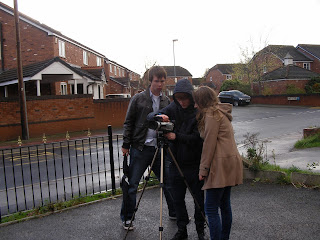Tuesday, 18th October
Our first day of filming was in Culcheth, a large village in Warrington. We decided that this was a suitable place to film as there are many takeaway restaurants located nearby to each other, which would make tasks such as filming restaurants for cutaway shots easy, quick, and practical. Furthermore, two of our group members live in Culcheth and therefore had links with people working in local takeaway restaurants as well as a general knowledge of the area: this would allow us to make the best use of our time by filming a lot of varied footage in a short time without wasting time. We met at around midday as we wanted to get our outdoor filming done in daylight whilst not having too much time to spare afterwards, as we were aware that we could not order a takeaway to film until 5:30pm. Unfortunately the weather for mainly rainy on this day, which had a negative impact on some shots as well as when and where we could film due to us not being able to put any electrical equipment out in the rain. We did bring an umbrella to help shield the camera when possible but it was still not ideal.

















































